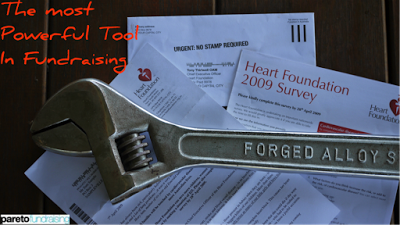Understanding Donors
The most important asset a fundraising organisation has is its database of supporters. But only if it is actually recording useful information.
Luckily, most organisations record main contact details plus transactions. In other words, you know where someone lives, hopefully, you have their phone number and email address and you know how much they donated and when.
Basic analysis of this data can help you predict how likely people are to donate to you and how much. If communications that have been sent are also analysed you can even work out what donors are most likely to respond to, too.
This basic data is crucial for making a basic direct marketing program work. But to make charity direct marketing fly we need to build relationships, and we do that through respecting our donors and their wishes. And we do that by using the most powerful fundraising tool ever – the Supporter Connection Survey.
Achieving Many Goals
This multi-function device, used well, will also help corporate, major donors, events, donor retention, and bequests. It can even be used for PR purposes, and it usually makes a profit on its own.
These are real surveys, getting really useful information, they are not scientific research and shouldn’t pretend to be. Even so, be honest with the donor – you want their opinion and to be able to communicate better with them, but you can also share their views with the public.
Short-term Benefits
Our tests have shown that despite running a survey to get data including a direct ask does not suppress response. In other words, using the survey as an actual fundraising appeal subject works.
You should aim to break even but what we have found is that when a survey is sent to donors who have responded to a previous appeal through the post, the survey actually makes a profit.
The Australian Conservation Foundation has been using surveys as an integral part of its donor communications strategy for some time now. Their first survey was mailed to over 25,000 donors and nearly one in four responded – half with a gift. They not only received a ton of useful information but made a $50K ‘profit’ as well.
Information taken from the surveys is then reflected back to the donors in future communications. For example, if a donor is motivated and interested in climate change, but an appeal is about forests then the letter should be personalised to connect the donors’ concerns with the subject of the appeal.
Important Note: The sort of surveys I am talking about tell us how to communicate better with individual donors. They are NOT quantitative research tools!
Medium Term
Appeal results and retention can be improved by clever use of survey information, and their completed survey is The Perfect Aide Memoir to take with you with when meeting a major donor. It pretty much tells you what to ask for!
But most charities who use the survey wisely get medium-term returns on their regular giving. For example, The Lost Dogs’ Home uses surveys to gather pet names. It has found that this is crucial for building relationships. They include personalisation in appeal letters mentioning the donors’ pet name:
“Thank you so much Sean, and please give Bilbo an extra cuddle from all of us at The Lost Dogs’ Home!”
But they also use it in phone conversations with donors. When asking donors to increase their monthly gifts, known as ‘upgrade calls’ our caller asks after the health of the donor’s pet.
The Pareto Phone team compared the upgrade success rate of donors we spoke with where we knew pet name against those where we had no pet name. The results are extraordinary:
Knowing Bilbo – a great way to see the value of listening to donors and reflecting back what you heard in future communications.
And the Long Term
Already surveys have proven their worth. You can see how using them for donor care, appeals and upgrades can work really well, and make them a useful part of the mix. But the biggest return comes from bequests. Specifically using surveys to generate bequest (legacy) leads.
The best measure a bequest fundraiser has to monitor their performance is a count of people who have mentioned the charity in their Will. We call these ‘confirmed bequestors.’
By asking the right questions, we can identify these and also bequest ‘prospects’ – i.e. those most likely to become confirmed bequestors.
A well thought through approach ‘burying’ the bequest question in a survey obliterates any other method of bequest marketing I have ever seen.
For example, Australian National Heart Foundation had seven full-time equivalent bequest officers working traditional bequest marketing techniques for seven years to get around 1,500 confirmed bequests. A brilliant achievement and potentially worth $75m, producing a huge return on investment.
But a year of surveys with follow up mail and phone acquired another 1,500. The charity now uses a combination of both techniques to drive more bequests.
And the surveys keep working. The Lost Dogs’ Home now has about fifteen (!) percent of key financial supporters who have put the charity in their will.
A Word of Warning
Don’t rush out and do surveys without ensuring you can follow them up, record the results and actually use the data in communications with your donors.
It is not as easy as just writing a survey – a good survey needs a great cover letter, it asks questions that help you understand what motivates your donors (avoid questions like ‘how many times they like to be mailed?’), a bequest conversion pack and trained people to follow up leads. And remember, a bequest lead from a survey is only ‘hot’ for a few weeks with conversion success dropping off dramatically the longer you leave it.
Learn all how you can create those perfect surveys for your donors by checking out our Supporter Connection Survey Course. It’s available for all members in The Fundraisingology Lab.
Sean











